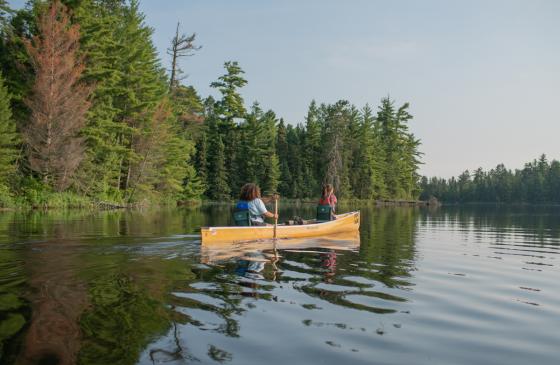Updated May 2023
Paddling season is finally here! Kind of.
Now that May has begun, the use of overnight paddle permits are required for multi-day Boundary Waters canoe trips until Sept. 30. But once again, "spring" has slowed the arrival of paddling conditions in Northeastern Minnesota.
The early months of paddling season in the Boundary Waters can be an excellent time to experience the Wilderness with fewer crowds than in the warmer months of July and August. However, the potential for lingering ice and low water temperatures makes cold-water safety a necessity for a successful trip.
Maddie Fahnline, a Regional Organizer for the Campaign to Save the Boundary Waters, also works as a professional guide in Ely, Minnesota. She holds a Wilderness First Responder certification and has spent multiple seasons guiding at Ely Outfitting Company and the Northern Lakes Girl Scout Canoe Base.
Here are Maddie’s recommendations for cold-water paddling and camping:
What are your top 3 tips for someone looking to recreate outdoors during a shoulder season when thin ice and cold water are a concern?
-
Be extra cautious. People are assuming the water will be the same as it is in August, and that’s just not the case. Try to exercise double or triple the amount of caution you would during a trip in warmer conditions.
-
Bring extra layers: Ideally, you should have two extra layers. That way, if you flip your canoe into cold water, you’ve got an extra layer to dry you off and another backup just in case.
-
Wear your lifejacket: Personal flotation devices are essential year-round, but especially when the water is cold enough to induce shock. Whether you’re paddling through cold water or walking on ice, keep your PFD on at all times.
What clothing should people focus on wearing in cold-water conditions?
Wool is the ideal clothing material to wear when cold water is a factor, as it can keep you warm even when wet. Synthetic materials like polyester will also work until they get wet, but avoid cotton. Once cotton gets wet, it stays wet for long periods of time and cannot warm you. Lastly, keep your wool in reserve, if you only have one change of it.
Additionally, make sure to have a thought-out plan for your feet. If you plan on wearing wet boots while canoeing, make sure that you change into dry shoes once you’re out of the boat for the day.
What should someone do if they fall through ice or out of their boat into extremely cold water?
If you’re canoeing through cold water and fall in, get to shore as quickly as possible. Once on shore, change out of your wet layers and find a way to get dry and warm fast. If you’re walking on ice and fall through, Maddie says keeping an emergency ice pick on your person can be a life-saver if the ice is sturdy enough to climb back onto. If the ice has broken up, focus on getting to shore. In any scenario, your priority should be getting out of the water and into a dry layer of clothes.
What are good ways to judge whether ice conditions have become too hazardous?
Ice can always be dangerous, and you shouldn’t ever assume it can hold your weight, especially during shoulder seasons. Be especially cautious of areas with moving water, such as streams or bottle-necked sections of lakes. Ice conditions may be better if you’re on stagnant lakes, but caution should still be exercised.
Another factor to consider is the movement of ice on the lake. Even if part of a section of lake looks open, the wind can move the ice still on the lake and block you in. Make sure to keep track of wind speed and direction, and avoid being near ice if you can help it. A capsize near the edge of an ice surface can be fatal. Not only is there immediate danger from exposure to cold water, currents or wind can force a paddler back under the edge of the ice - with no immediate openings for escape or rescue.
Can water temperatures still be hazardous even if ice out has occurred?
Absolutely! Outfitters near the Boundary Waters caution visitors about water temperatures throughout May and June. Even if ice has completely melted, the water temperature can still be anywhere from 35 to 60 degrees. Exposure to cold water can be extremely dangerous, and paddlers should remain careful.
What are good resources to find up-to-date info on water and ice conditions?
There are a number of resources available for recent information about conditions in the Boundary Waters. Outfitters and Forest Service Rangers both do frequent checks of conditions to ensure safety and keep paddlers in-the-know about water conditions. Additionally, a number of local residents and canoe enthusiasts check ice and water temperatures to post on BWCA Facebook groups and forums.
